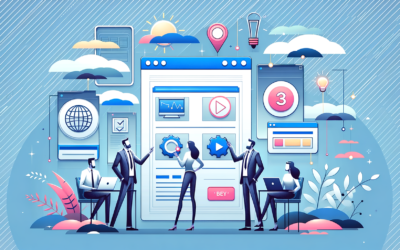In the rapidly evolving digital landscape of 2024, understanding cloud computing has become essential for businesses and individuals alike. Cloud computing offers a flexible and scalable solution for data storage, application hosting, and IT infrastructure management. As more organizations transition to cloud-based services, it is crucial to grasp the fundamentals of this technology, its benefits, and how to leverage it effectively. This article aims to provide a comprehensive guide on cloud computing, catering to beginners, small business owners, and IT professionals, while also addressing the latest trends and best practices.
What Is Cloud Computing In 2024?
Cloud computing refers to the delivery of computing services over the internet, allowing users to access and store data remotely rather than relying on local servers or personal computers. In 2024, cloud computing encompasses several key concepts:
- Infrastructure as a Service (IaaS): Provides virtualized computing resources over the internet, allowing businesses to rent servers and storage.
- Platform as a Service (PaaS): Offers a platform for developers to build, deploy, and manage applications without worrying about the underlying infrastructure.
- Software as a Service (SaaS): Delivers software applications over the internet on a subscription basis, eliminating the need for installation and maintenance.
The evolution of cloud computing technology has transformed how businesses operate, enabling them to be more agile and responsive to market demands.
Benefits Of Cloud Computing In 2024
The advantages of cloud computing are numerous and impactful, particularly in 2024:
- Cost Savings And Scalability: Cloud services often operate on a pay-as-you-go model, allowing businesses to scale their resources according to demand without incurring significant upfront costs.
- Flexibility And Remote Access: Employees can access cloud-based applications and data from anywhere with an internet connection, promoting remote work and collaboration.
- Enhanced Collaboration And Productivity: Cloud computing facilitates real-time collaboration among teams, improving productivity and project management.
- Improved Data Security And Disaster Recovery: Leading cloud providers implement robust security measures and offer disaster recovery solutions, ensuring data is protected and recoverable in case of an incident.
Cloud Computing For Beginners In 2024
For those new to cloud computing, understanding the terminology and concepts can be daunting. Here are some simple explanations to get started:
- Cloud Storage: A service that allows users to store data on remote servers, accessible via the internet.
- Virtual Machines: Emulated computers that run on physical servers, allowing multiple operating systems to operate on a single hardware platform.
- APIs (Application Programming Interfaces): Tools that allow different software applications to communicate with each other.
To dive deeper into cloud computing, consider exploring online courses, webinars, and tutorials that cater to beginners.
Cloud Computing Trends In 2024
As technology continues to advance, several trends are shaping the future of cloud computing:
- Emerging Technologies: The integration of artificial intelligence (AI), machine learning, and edge computing is enhancing cloud capabilities, enabling smarter data processing and analysis.
- Sustainability Focus: Businesses are increasingly adopting green cloud solutions, prioritizing energy efficiency and reducing their carbon footprint.
- Multi-Cloud And Hybrid Strategies: Organizations are leveraging multiple cloud providers to avoid vendor lock-in and enhance flexibility, leading to the growth of hybrid cloud environments.
Cloud Computing Applications For Businesses
Cloud computing has a wide range of applications across various industries:
- Healthcare: Cloud solutions enable secure storage and sharing of patient data, improving care coordination and compliance with regulations.
- Finance: Financial institutions utilize cloud computing for data analytics, risk management, and regulatory compliance.
- Retail: Cloud-based platforms facilitate inventory management, customer relationship management (CRM), and e-commerce operations.
Successful cloud implementations have demonstrated significant improvements in operational efficiency and customer satisfaction.
How To Use Cloud Computing Effectively
To maximize the benefits of cloud computing, consider the following best practices:
- Assess Your Needs: Identify the specific requirements of your business and choose cloud services that align with your goals.
- Optimize Resources: Regularly monitor and adjust your cloud usage to avoid unnecessary costs and ensure optimal performance.
- Invest In Training: Provide your team with the necessary training and support to effectively utilize cloud services and tools.
How To Implement Cloud Computing Solutions
Migrating to the cloud can seem overwhelming, but following a structured approach can simplify the process:
- Evaluate Your Current Infrastructure: Assess your existing IT setup and determine which applications and data can be migrated to the cloud.
- Choose The Right Cloud Model: Decide between public, private, or hybrid cloud solutions based on your business needs.
- Plan The Migration: Develop a detailed migration plan, including timelines, resources, and potential risks.
- Execute The Migration: Use tools and platforms designed to facilitate cloud migration, ensuring minimal disruption to your operations.
Cloud Computing Security Best Practices In 2024
Security remains a top concern for organizations adopting cloud computing. Here are some best practices to ensure data protection:
- Implement Strong Access Controls: Use multi-factor authentication and role-based access controls to safeguard sensitive information.
- Regularly Update Security Protocols: Stay informed about the latest security threats and update your protocols accordingly.
- Conduct Security Audits: Regularly assess your cloud security measures and compliance with industry regulations.
Choosing The Right Cloud Service Provider
Selecting a cloud service provider is a critical decision. Consider the following factors:
- Cost: Compare pricing models and ensure they align with your budget.
- Features: Evaluate the features offered by different providers and choose one that meets your specific needs.
- Support: Look for providers that offer robust customer support and service level agreements (SLAs) to ensure reliability.
Cloud Computing Cost Analysis In 2024
Understanding the costs associated with cloud computing is essential for effective budgeting:
- Subscription Models: Many cloud services operate on a subscription basis, allowing for predictable monthly expenses.
- Pay-As-You-Go: This model charges based on actual usage, making it ideal for businesses with fluctuating demands.
- ROI Considerations: Assess the potential return on investment by comparing the costs of cloud services against the benefits gained.
Cloud Computing Vs Traditional IT Infrastructure
When comparing cloud computing to traditional IT infrastructure, several key differences emerge:
- Cost Efficiency: Cloud computing typically requires lower upfront investments and offers more flexible pricing models.
- Scalability: Cloud services can be easily scaled up or down based on demand, while traditional infrastructure may require significant time and resources to adjust.
- Maintenance: Cloud providers handle maintenance and updates, freeing up internal IT teams to focus on strategic initiatives.
Future Of Cloud Computing Technology
The future of cloud computing is promising, with several advancements on the horizon:
- Quantum Computing: This emerging technology has the potential to revolutionize data processing capabilities in the cloud.
- Increased Automation: Automation tools will streamline cloud management, making it easier for businesses to optimize their resources.
- Enhanced Interoperability: Future cloud solutions will focus on seamless integration between different platforms and services, improving overall efficiency.
Conclusion
As we move further into 2024, the importance of cloud computing cannot be overstated. Understanding its benefits, trends, and best practices will empower businesses and individuals to harness its full potential. By exploring cloud solutions and implementing effective strategies, organizations can enhance their operations and stay competitive in an increasingly digital world. If you are in need of any IT or Cloud services, you can contact us or book a call with us today.
Key Points
- Cloud computing offers flexible, scalable solutions for data storage and application hosting.
- Key benefits include cost savings, remote access, enhanced collaboration, and improved security.
- Understanding cloud computing terminology is essential for beginners.
- Emerging trends include AI integration, sustainability, and multi-cloud strategies.
- Security best practices are crucial for protecting data in the cloud.
FAQs
What Is Cloud Computing?
Cloud computing is the delivery of computing services over the internet, allowing users to access and store data remotely.
What Are The Benefits Of Cloud Computing?
Benefits include cost savings, flexibility, enhanced collaboration, and improved data security.
How Can I Get Started With Cloud Computing?
Begin by assessing your needs, exploring cloud services, and utilizing online resources for learning.
What Are The Key Trends In Cloud Computing For 2024?
Emerging technologies, sustainability focus, and the growth of multi-cloud strategies are key trends.
How Do I Choose The Right Cloud Service Provider?
Consider factors such as cost, features, and support when selecting a cloud service provider.




